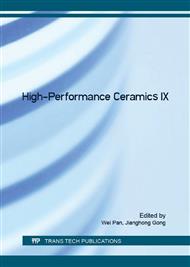p.303
p.307
p.311
p.318
p.322
p.327
p.333
p.337
p.341
Phase and Morphology Evolution of Manganese Oxides during Thermal Treatment
Abstract:
Core-shell structure with inner carbon spheres and outer MnO2 layer was successfully prepared in this study. Thermal treatment was further conducted to remove the carbon cores to get hollow MnO2 sphere. However, it was surprisingly found that the original MnO2 particles turn nanorods. Moreover, it is believed that the appearance of such one-dimensional morphology attributes to the fact that the original irregularly shaped particles of amorphous MnO2 change to mainly Mn3O4 fibers as a result of exposure to open air at room temperature and the fibers would convert to pyrolusite MnO2 with heat treatment. Continuous heating would induce phase transformation from MnO2 to Mn3O4 takes place at 900°C. Based on the XRD, SEM, TEM and TG-DSC analysis, we believe that the K+ intercalated into the MnO2 tunnels stabilizes the nanorods structure and prevents the tunnels from collapse.
Info:
Periodical:
Pages:
322-326
Citation:
Online since:
July 2016
Authors:
Keywords:
Price:
Сopyright:
© 2016 Trans Tech Publications Ltd. All Rights Reserved
Share:
Citation:


